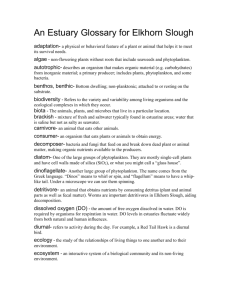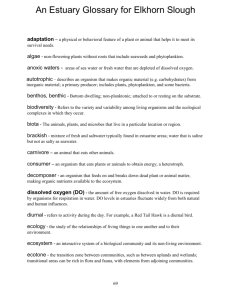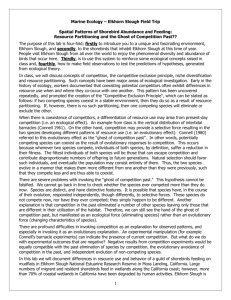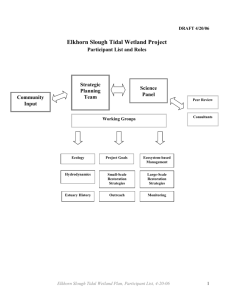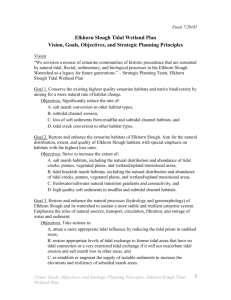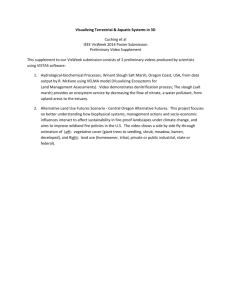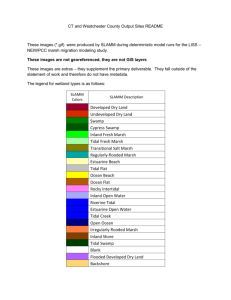Talking Points to Assist Docent Tours at South Marsh and Parsons
advertisement
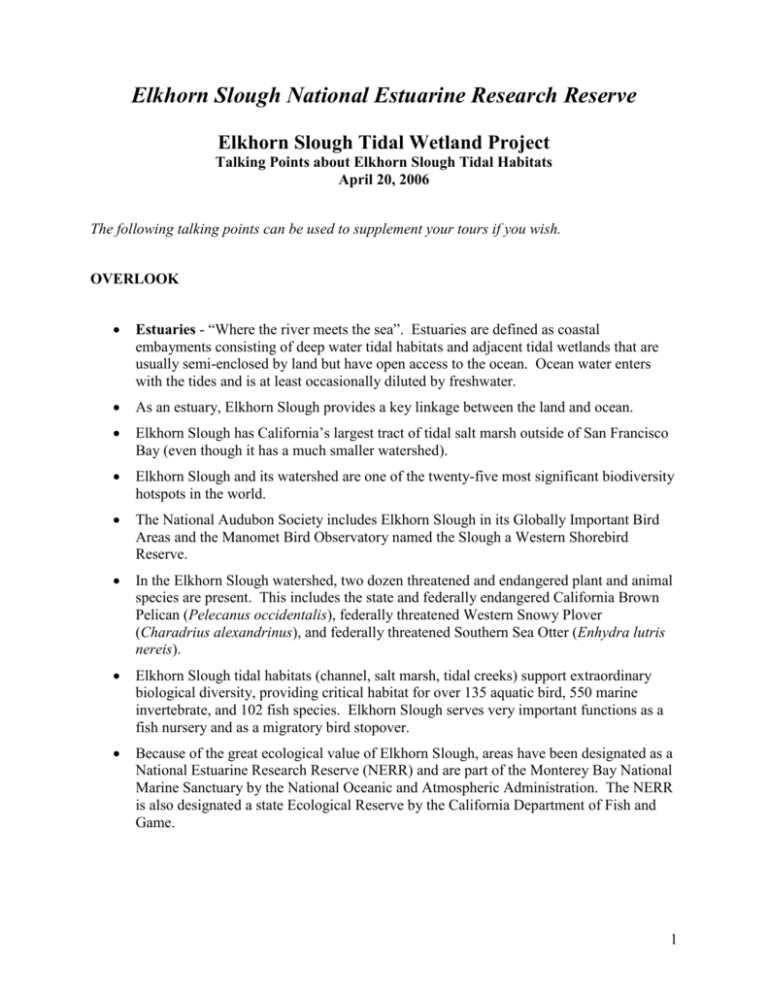
Elkhorn Slough National Estuarine Research Reserve Elkhorn Slough Tidal Wetland Project Talking Points about Elkhorn Slough Tidal Habitats April 20, 2006 The following talking points can be used to supplement your tours if you wish. OVERLOOK Estuaries - “Where the river meets the sea”. Estuaries are defined as coastal embayments consisting of deep water tidal habitats and adjacent tidal wetlands that are usually semi-enclosed by land but have open access to the ocean. Ocean water enters with the tides and is at least occasionally diluted by freshwater. As an estuary, Elkhorn Slough provides a key linkage between the land and ocean. Elkhorn Slough has California’s largest tract of tidal salt marsh outside of San Francisco Bay (even though it has a much smaller watershed). Elkhorn Slough and its watershed are one of the twenty-five most significant biodiversity hotspots in the world. The National Audubon Society includes Elkhorn Slough in its Globally Important Bird Areas and the Manomet Bird Observatory named the Slough a Western Shorebird Reserve. In the Elkhorn Slough watershed, two dozen threatened and endangered plant and animal species are present. This includes the state and federally endangered California Brown Pelican (Pelecanus occidentalis), federally threatened Western Snowy Plover (Charadrius alexandrinus), and federally threatened Southern Sea Otter (Enhydra lutris nereis). Elkhorn Slough tidal habitats (channel, salt marsh, tidal creeks) support extraordinary biological diversity, providing critical habitat for over 135 aquatic bird, 550 marine invertebrate, and 102 fish species. Elkhorn Slough serves very important functions as a fish nursery and as a migratory bird stopover. Because of the great ecological value of Elkhorn Slough, areas have been designated as a National Estuarine Research Reserve (NERR) and are part of the Monterey Bay National Marine Sanctuary by the National Oceanic and Atmospheric Administration. The NERR is also designated a state Ecological Reserve by the California Department of Fish and Game. 1 SOUTH MARSH BOARDWALK OR PARSONS SLOUGH OVERLOOK Wetlands are transitional areas between terrestrial and aquatic systems where the water table is usually at or near the surface or the land is covered by shallow water. Wetlands are areas that are inundated or saturated by surface or groundwater (wetland hydrology) at a frequency and duration sufficient to support (under normal circumstances) a prevalence of vegetation typically adapted for life in saturated soil conditions (hydrophytic vegetation), the soils are undrained (hydric soils). A few of the ecosystem and socioeconomic functions of estuarine wetlands include nutrient cycling, habitat and food chain support, storage of flood waters, water quality improvement (act as filters to remove pollutants and sediments from moving waters), nursery for recreational and commercial marine fisheries, and a place for bird watching, artistic expression, and enjoyment of the natural scenary. Elkhorn Slough’s tidal habitats include subtidal areas (channel, tidal creeks) covered by water even at low tide and intertidal areas (mudfalt, salt marsh) that are covered with water during high tide and exposed during low tide. Low salt marsh habitat is usually covered with water during high tide and is exposed during low tide. The low salt marsh vegetation at Elkhorn Slough is primarily pickleweed (Salicornia virginica). High salt marsh habitat is flooded irregularly (usually exposed at least 10 continuous days) and the most common vegetation here is salt grass (Distichlis spicata var. stolonifera), alkali heath (Frankenia salina), jaumea (Jaumea carnosa), Atriplex species, and parasitic dodder (Cuscuta salina). The macroalgae that looks like lettuce leaves and covers the salt marsh in some areas is called Ulva (various species). Tidal creek habitats form a network in salt marshes and serve an important function transferring sediments and nutrients between salt marshes and the main channel and as an important habitat for estuarine fish. There are approximately 970 acres of salt marsh habitat (including tidal creeks) in Elkhorn Slough (this number does not include salt marsh in Moro Cojo or the Old Salinas River Channel). Mudflat habitats are covered with water during high tide and exposed during low tide, typically found below marsh habitats, and usually don’t have any vegetation cover. There are approximately 870 acres of mudflat habitats in Elkhorn Slough (this number does not include mudflats in Moro Cojo or the Old Salinas River Channel). In the United States during the past 200 years, the lower 48 states have lost an estimated 53% of the original 221 million acres of wetlands. It is estimated that 91 percent of California’s wetlands have been lost (from approximately 5 million to 450,000 acres). California has lost approximately 80% of the coastal salt marshes, 95% of the riparian wetlands, 90% of freshwater marshes, and 90% of the vernal pools. In Elkhorn Slough, approximately 50% of the salt marshes have been lost in the past 80 years. Marsh loss has been due to the diking and draining of wetlands for cattle grazing, railroad, roads, and freshwater impoundments for duck hunting. The cause of the continuing salt marsh loss is due to increased tidal flooding and tidal (bank and channel) erosion. The majority of salt marsh loss each year is caused by tidal flooding. 2 The modification of the Elkhorn Slough mouth for the creation of the Moss Landing Harbor in 1947, permanently fixing a deeper opening to Monterey Bay, is the main cause of subtidal erosion and more recent marsh loss/conversion. This deeper opening allows a larger amount of tidal waters to enter Elkhorn Slough (tidal volume) increasing the velocities, tidal erosion, and habitat loss. Contributing factors include the decreases in sediment supply (such as from the diversion of the Salinas River), dike/levee failure and removal, the presence of the Monterey Canyon, sea level rise, subsidence of marsh areas, wave action, and other biogeochemical processes. We acknowledge that the causes of marsh loss are complex, but can be mainly attributed to flooding due to subsidence (largely from diking) and increased tidal range, erosion due to increased tidal velocities, and lack of sediment supply. South Marsh/Parsons Slough - In the past, the 415 acres of South Marsh and Parsons Slough were extensively covered with salt marsh and tidal creeks. By 1956, the entire area was diked and drained primarily so that it could be used as pastureland for dairy cattle. The draining of the tidal marsh areas in the Parsons Slough and South Marsh caused the marsh sediments to dry out and compact by several feet (land subsidence) through a process of organic matter decomposition. In order to support vegetated tidal marsh, land elevations would have to be raised between 3 and 6 feet. During the winter of 1982-1983, the levee at the mouth of Parsons Slough breached (unintentionally) during a storm event allowing tidal waters to enter both South Marsh and Parsons Slough. A levee was rebuilt to keep tidal waters out of South Marsh while wetland enhancement activities such as the construction of habitat islands were taking place. In the fall of 1983, the South Marsh levee was breached (intentionally) restoring tidal exchange to this area. Bank erosion has significantly decreased the width and length of these habitat islands since they were first constructed because of the higher energy in the system due to the larger mouth opening. 3
